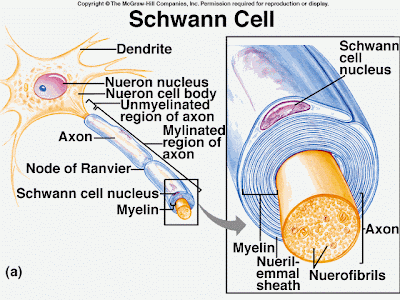I love when multiple classes overlap in what they're teaching me. Today it's Bio Organic Chemistry and Plant Biology.
Top half of the diagram below:
This is showing glucose. At first it's in open chain form. Then it becomes cyclized by forming a hemiacetal - a bond between the carbonyl on Carbon 1, and the alcohol on Carbon 5, which is where we get the Oxygen on the top right corner of all cyclized glucose molecules (was the carbonyl attached to Carbon 1).
Bottom half of the diagram:
This shows how the new hemiacetal can be twisted one way or another so that when the bond is made, the alcohol from carbon 5 is either facing up or down off of its new home on Carbon 1. The glucose on the left shows the OH on the bottom, so it's considered the alpha form. The glucose on the right shows the OH on top, which is the beta form. (Memory Aid: Alpha= the letter looks like a fish, which swim below the surface so the OH is pointed downward, Beta= "B" is for bird, which flies above the surface so the OH is above.)
So we have 2 forms of D-Glucose in biology. Now we can see an example of how they can be put together into polymers in plants.
Starch
Starch is a string of glucose attached by alpha glycoside bonds. I made some little drawings to walk us through how these look.
1) We start with two alpha-D-glucose molecules next to each other which looks like this:
Notice they are both in the alpha configuration because the OH is on the bottom for Carbon 1. Ooops forgot to label the Carbon numbers until later, sorry. Carbon 1 is the one on the right end of each hexagon.)
2) Now we will bond these together using dehydration synthesis by removing an OH hydroxide from one side, and just the H from the hydroxide group on the other side. This becomes a water molecule which is a byproduct. We took water out so that's why it's called
dehydration synthesis.
3) So now we can see that these two glucose molecules are bound together by the one Oxygen that was left over. This is an alpha-1-4-glycoside bond. The 1 and 4 are because it's between Carbon 1 on the glucose on the left, and Carbon 4 of the glucose on the right, as I circled on the picture below, with the now labeled Carbon numbers. :)
4) Make this bond many times, and you will get a big starch chain held together by many alpha glucose bonds, like so:
Cellulose
Cellulose is put together differently because it uses Beta-D-glucose.
1) Two Beta-D-Glucose molecules next to each other, and we could pull out the water molecule from this like so:
2) But notice that it's a little awkward, so instead we flip one of the glucose molecules upside down, which you can tell by the H2COH group being on the bottom of the glucose on the right.
Now the OH's match up better so we can make the glycoside bond.
3) Here's our brand new Beta Glycoside bond, more specifically a Beta-1-4-Glycoside bond
4) And once again we can make a nice chain of these, and you can notice how every other glucose molecule is flipped upside down.
There's our cellulose! Enjoy, hope you learned something, and I hope my drawings were clear enough to make sense. Stay curious!
P.S. Fun side note - this is my very first Bio/ Organic Chemistry post on the blog! Have to add a new label to the cloud..woohoo! :)



































































